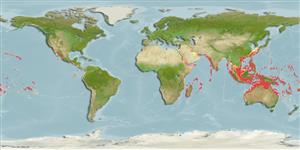Environment: milieu / climate zone / depth range / distribution range
Ecologie
marien rifbewoner; diepte 0 - 122 m (Ref. 1602). Tropical; 34°N - 32°S, 26°E - 77°W
Indo-Pacific: East Africa to Hawaii and the Easter Island, north to southern Japan south to Lord Howe Island. Eastern Central Pacific: Panama, Revillagigedo Islands, Clipperton Island, Cocos Island, and Malpelo Island (Ref. 9275).
Grootte / Gewicht / Leeftijd
Maturity: Lm ? range ? - ? cm
Max length : 80.0 cm TL mannelijk / geslacht onbekend; (Ref. 2334); common length : 60.0 cm TL mannelijk / geslacht onbekend; (Ref. 55763)
Korte beschrijving
Determinatiesleutels | Morfologie | Morfometrie
Dorsale stekels (totaal) : 8 - 12; Dorsale zachte stralen (totaal) : 24 - 27; Anale stekels: 0; Anale zachte stralen: 26 - 29. Occurs in three basic color phases: uniformly brown to green, mottled brown to green, or uniformly yellow. First dorsal fin consists of a series of isolated spines, followed by a second dorsal fin consisting of rays. The second dorsal fin is shaped like the anal fin and is found directly above it. A black maxillary stripe usually present, but may be reduced; dorsal and anal fins light, but with a dark basal bar; caudal fin usually with two round black spots; a black spot at the base of each pelvic fin (Ref. 9825).
Found in clear, shallow water (Ref. 9275), in rocky and coral areas of protected and seaward reefs (Ref. 1602, 58302, 58534, 58652). Benthopelagic (Ref. 58302). Feeds on small fishes and shrimps (Ref. 9275). A slow-moving fish relying partly on stealth and camouflage to sneak up on unsuspecting prey. Often darts down vertically on its prey. Usually solitary (Ref. 48635). Minimum depth reported taken from Ref. 128797.
Levenscyclus en paargedrag
Maturiteit | Voortplanting | Paaien | Eieren | Fecunditeit | Larven
Oviparous, gonochorous, with pelagic eggs (Ref. 101194).
Fritzsche, R.A., 1984. Aulostomidae. In W. Fischer and G. Bianchi (eds.) FAO species identification sheets for fishery purposes. Western Indian Ocean fishing area 51. Vol. 1. (Ref. 3309)
Status op de Rode Lijst van het IUCN (Ref. 130435: Version 2024-1)
Gevaar voor de mens
Harmless
Gebruik door de mens
Visserij: van minder commercieel belang; Aquarium: Commercieel
Tools
Speciale rapporten
Download XML
Internetbronnen
Estimates based on models
Preferred temperature (Ref.
123201): 24.2 - 28.9, mean 27.7 °C (based on 1234 cells).
Fylogenetische diversiteitsindex (Ref.
82804): PD
50 = 0.7500 [Uniqueness, from 0.5 = low to 2.0 = high].
Bayesian length-weight: a=0.00059 (0.00036 - 0.00097), b=3.25 (3.10 - 3.40), in cm total length, based on LWR estimates for this species & (Sub)family-body (Ref.
93245).
Trofisch niveau (Ref.
69278): 4.2 ±0.75 se; based on food items.
Fishing Vulnerability (Ref.
59153): Moderate to high vulnerability (52 of 100).
Nutrients (Ref.
124155): Calcium = 46.7 [25.3, 85.6] mg/100g; Iron = 0.785 [0.429, 1.444] mg/100g; Protein = 18.4 [17.3, 19.6] %; Omega3 = 0.11 [0.06, 0.22] g/100g; Selenium = 75.2 [39.1, 159.2] μg/100g; VitaminA = 38.1 [14.0, 106.1] μg/100g; Zinc = 0.891 [0.598, 1.324] mg/100g (wet weight);
